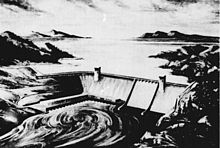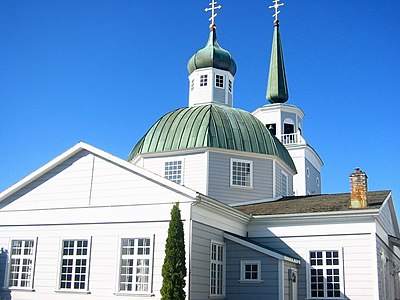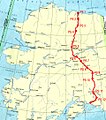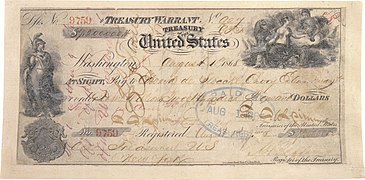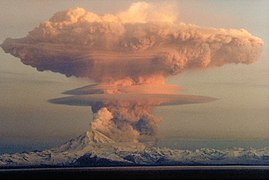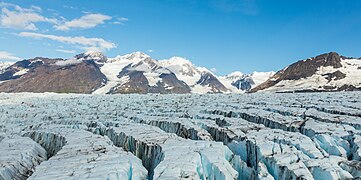Portal:Alaska
 Introduction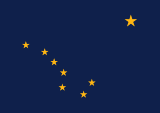   Alaska (/əˈlæskə/ ⓘ ə-LASS-kə) is a non-contiguous U.S. state on the northwest extremity of North America. It borders the Canadian province of British Columbia and the Yukon territory to the east; it shares a western maritime border in the Bering Strait with Russia's Chukotka Autonomous Okrug. The Chukchi and Beaufort Seas of the Arctic Ocean lie to the north and the Pacific Ocean lies to the south. Technically a semi-exclave of the U.S., it is the largest exclave in the world. Alaska is the largest U.S. state by area, comprising more total area than the next three largest states of Texas, California and Montana combined, and is the seventh-largest subnational division in the world. It is the third-least populous and most sparsely populated U.S. state, but is, with a population of 736,081 as of 2020, the continent's most populous territory located mostly north of the 60th parallel, with more than quadruple the combined populations of Northern Canada and Greenland. The state contains the second-largest and largest cities in the United States by area: the state capital of Juneau, and its former capital, Sitka, respectively. The state's most populous city is Anchorage and approximately half of Alaska's residents live within its metropolitan area. Indigenous people have lived in Alaska for thousands of years, and it is widely believed that the region served as the entry point for the initial settlement of North America by way of the Bering land bridge. The Russian Empire was the first to actively colonize the area beginning in the 18th century, eventually establishing Russian America, which spanned most of the current state, and promoted and maintained a native Alaskan Creole population. The expense and logistical difficulty of maintaining this distant possession prompted its sale to the U.S. in 1867 for US$7.2 million (equivalent to $157 million in 2023). The area went through several administrative changes before becoming organized as a territory on May 11, 1912. It was admitted as the 49th state of the U.S. on January 3, 1959. Abundant natural resources have enabled Alaska—with one of the smallest state economies—to have one of the highest per capita incomes, with commercial fishing, and the extraction of natural gas and oil, dominating Alaska's economy. U.S. Armed Forces bases and tourism also contribute to the economy; more than half the state is federally-owned land containing national forests, national parks, and wildlife refuges. It is among the most irreligious states, one of the first to legalize recreational marijuana, and is known for its libertarian-leaning political culture, generally supporting the Republican Party in national elections. The Indigenous population of Alaska is proportionally the second highest of any U.S. state, at over 15 percent, after only Hawaii. (Full article...) Entries here consist of Good and Featured articles, which meet a core set of high editorial standards.
The Rampart Dam or Rampart Canyon Dam was a project proposed in 1954 by the U.S. Army Corps of Engineers to dam the Yukon River in Alaska for hydroelectric power. The project was planned for Rampart Canyon (also known as Rampart Gorge) just 31 miles (50 km) southwest of the village of Rampart, Alaska, about 105 miles (169 km) west-northwest of Fairbanks. The resulting dam would have created a lake roughly the size of Lake Erie, making it the largest human-made reservoir in the world. The plan for the dam itself called for a concrete structure 530 feet (162 m) high with a top length of about 4,700 feet (1,430 m). The proposed power facilities would have consistently generated between 3.5 and 5.0 gigawatts of electricity, based on the flow of the river as it differs between winter and summer. Though supported by many politicians and businesses in Alaska, the project was canceled after objections were raised. Native Alaskans in the area protested the threatened loss of nine villages that would be flooded by the dam. Conservation groups abhorred the threatened flooding of the Yukon Flats, a large area of wetlands that provides a critical breeding ground for millions of waterfowl. Fiscal conservatives opposed the dam on the grounds of its large cost and limited benefit to Americans outside Alaska. (Full article...)TopicsCategoriesSelected article -Fairbanks is a home rule city and the borough seat of the Fairbanks North Star Borough, Alaska, United States. Fairbanks is the largest city in the Interior region of Alaska and the second largest in the state. The 2020 Census put the population of the city proper at 32,515 and the population of the Fairbanks North Star Borough at 95,655, making it the second most populous metropolitan area in Alaska after Anchorage. The Metropolitan Statistical Area encompasses all of the Fairbanks North Star Borough and is the northernmost Metropolitan Statistical Area in the United States, located 196 miles (315 kilometers) by road (140 mi or 230 km by air) south of the Arctic Circle. In August 1901, E.T. Barnette founded a trading post on the south bank of the Chena River. A gold discovery near the trading post sparked the Fairbanks Gold Rush, and many miners moved to the area. There was a boom in construction, and in November 1903 the area's residents voted to incorporate Fairbanks as a city. Barnette became the first mayor, and the city flourished during the gold rush. By World War I, the population had plunged, but rose again during the Great Depression as the price of gold increased. During the 1940s and 1950s, the city became a staging area for the construction of military depots during World War II and the Cold War. Fort Wainwright, previously named Ladd Field, was built east of the city beginning in 1938 and is operated by the U.S. Army. After the discovery of the Prudhoe Bay Oil Field in 1968, the city became a supply point for the oil field, as well as for the Trans-Alaska Pipeline System. With the establishment of the Fairbanks North Star Borough in 1964, the city became borough seat. Tourism is also a factor in Fairbanks' economy. (Full article...)Selected picture -General imagesThe following are images from various Alaska-related articles on Wikipedia.
Recognized content
Featured articlesGood articles
Featured pictures
Former featured pictures
Related Portals
Related WikiProjectsState facts
State symbols:
Tasks
Associated WikimediaThe following Wikimedia Foundation sister projects provide more on this subject:
Discover Wikipedia using portals |

